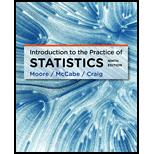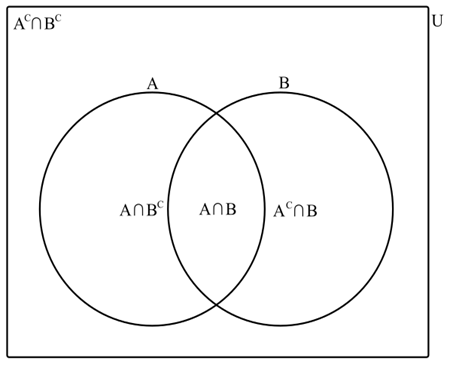
Concept explainers
To graph: The Venn diagram that shows the relation between the events A and B in Exercise 4.112.
Explanation of Solution
Calculation: The
Graph: The Venn diagram indicating the above probabilities and depicting the events

(a)
The probability for the event { A and B }
Answer to Problem 114E
Solution: The required probability is 0.082.
Explanation of Solution
Hence, the required probability is 0.082.
To explain: THE event
Answer to Problem 114E
Solution: The event
Explanation of Solution
(b)
The probability for the event { A C and B }
(b)
Answer to Problem 114E
Solution: The required probability is 0.179.
Explanation of Solution
Hence, the required probability is 0.179.
To explain: The event
Answer to Problem 114E
Solution: The event
Explanation of Solution
(c)
The probability for the event { A and B C }
(c)
Answer to Problem 114E
Solution: The required probability is 0.056.
Explanation of Solution
Hence, the required probability is 0.056.
To explain: The event
Answer to Problem 114E
Solution: The event
Explanation of Solution
(d)
The probability for the event { A C and B C }
(d)
Answer to Problem 114E
Solution: The required probability is 0.683.
Explanation of Solution
Hence, the required probability is 0.683.
To explain: The event
Answer to Problem 114E
Solution: The event
Explanation of Solution
Want to see more full solutions like this?
Chapter 4 Solutions
Introduction to the Practice of Statistics
 MATLAB: An Introduction with ApplicationsStatisticsISBN:9781119256830Author:Amos GilatPublisher:John Wiley & Sons Inc
MATLAB: An Introduction with ApplicationsStatisticsISBN:9781119256830Author:Amos GilatPublisher:John Wiley & Sons Inc Probability and Statistics for Engineering and th...StatisticsISBN:9781305251809Author:Jay L. DevorePublisher:Cengage Learning
Probability and Statistics for Engineering and th...StatisticsISBN:9781305251809Author:Jay L. DevorePublisher:Cengage Learning Statistics for The Behavioral Sciences (MindTap C...StatisticsISBN:9781305504912Author:Frederick J Gravetter, Larry B. WallnauPublisher:Cengage Learning
Statistics for The Behavioral Sciences (MindTap C...StatisticsISBN:9781305504912Author:Frederick J Gravetter, Larry B. WallnauPublisher:Cengage Learning Elementary Statistics: Picturing the World (7th E...StatisticsISBN:9780134683416Author:Ron Larson, Betsy FarberPublisher:PEARSON
Elementary Statistics: Picturing the World (7th E...StatisticsISBN:9780134683416Author:Ron Larson, Betsy FarberPublisher:PEARSON The Basic Practice of StatisticsStatisticsISBN:9781319042578Author:David S. Moore, William I. Notz, Michael A. FlignerPublisher:W. H. Freeman
The Basic Practice of StatisticsStatisticsISBN:9781319042578Author:David S. Moore, William I. Notz, Michael A. FlignerPublisher:W. H. Freeman Introduction to the Practice of StatisticsStatisticsISBN:9781319013387Author:David S. Moore, George P. McCabe, Bruce A. CraigPublisher:W. H. Freeman
Introduction to the Practice of StatisticsStatisticsISBN:9781319013387Author:David S. Moore, George P. McCabe, Bruce A. CraigPublisher:W. H. Freeman





